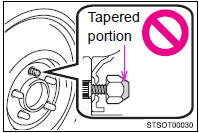Toyota Venza: Wheels
If a wheel is bent, cracked or heavily corroded, it should be replaced.
Otherwise, the tire may separate from the wheel or cause loss of handling control.
- Wheel selection
When replacing wheels, care should be taken to ensure that they are equivalent to those removed in load capacity, diameter, rim width, and inset*.
Replacement wheels are available at your Toyota dealer.
*: Conventionally referred to as “offset”.
Toyota does not recommend using:
• Wheels of different
sizes or types
• Used wheels
• Bent wheels that have been straightened
- Aluminum wheel precautions
• Use only Toyota wheel nuts and wrenches designed for use with your aluminum wheels.
• When rotating, repairing or changing your tires, check that the wheel nuts are still tight after driving 1000 miles (1600 km).
• Be careful not to damage the aluminum wheels when using tire chains.
• Use only Toyota genuine balance weights or equivalent and a plastic or rubber hammer when balancing your wheels.
- When replacing wheels
The wheels of your Toyota are equipped with tire pressure warning valves and transmitters that allow the tire pressure warning system to provide advanced warning in the event of a loss in tire inflation pressure.
Whenever wheels are replaced, the tire pressure warning valves and transmitters must be installed.
CAUTION
- When replacing wheels
• Do not use wheels that are a different size from those recommended in the Owner’s Manual, as this may result in loss of handling control.
• Never use an inner tube in a leaking wheel which is designed for a tubeless tire. Doing so may result in an accident, causing death or serious injury.
CAUTION
- When installing the wheel nuts

• Be sure to install the wheel nuts with the tapered ends facing inward.
Installing the nuts with the tapered ends facing outward can cause the wheel to break and eventually cause the wheel to come off while driving, which could lead to an accident resulting in death or serious injury.
• Never use oil or grease on the wheel bolts or wheel nuts.
Oil and grease may cause the wheel nuts to be excessively tightened, leading to bolt or disc wheel damage. In addition, the oil or grease can cause the wheel nuts to loosen and the wheel may fall off, causing an accident and resulting in death or serious injury. Remove any oil or grease from the wheel bolts or wheel nuts.
NOTICE
- Replacing tire pressure warning valves and transmitters
• Because tire repair or replacement may affect the tire pressure warning valves and transmitters, make sure to have tires serviced by your Toyota dealer or other qualified service shop. In addition, make sure to purchase your tire pressure warning valves and transmitters at your Toyota dealer.
• Ensure that only genuine Toyota wheels are used on your vehicle.
Tire pressure warning valves and transmitters may not work properly with non-genuine wheels.
 Tire inflation pressure
Tire inflation pressure
- Tire inflation pressure
The recommended cold tire inflation pressure and tire size is displayed on the
tire and loading information label.
- Inspection and adjustment procedure
...
 Air conditioning filter
Air conditioning filter
The air conditioning filter must be changed regularly to maintain air conditioning
efficiency.
- Removal method
Vehicles with smart key system:
Turn the “ENGINE START STOP” switch off. ...
Other materials about Toyota Venza:
Data List / Active Test
DATA LIST / ACTIVE TEST
1. DATA LIST
NOTICE:
In the table below, the values listed under "Normal Condition" are reference
values. Do not depend solely on these reference values when deciding whether a part
is faulty or not.
HINT:
Using the T ...
Reassembly
REASSEMBLY
PROCEDURE
1. BEARING POSITION
(a) Check each bearing position and installation direction.
Mark
Front Race Diameter
Inside / Outside mm (in.)
Thrust Bearing Diameter
Inside / Outside mm (in.)
...
Inspection
INSPECTION
PROCEDURE
1. INSPECT TIE ROD ASSEMBLY LH
(a) Secure the tie rod assembly LH in a vise.
(b) Install the nut to the stud bolt.
(c) Flip the ball joint back and forth 5 times.
(d) Set a to ...
0.1395
